Readings Newsletter
Become a Readings Member to make your shopping experience even easier.
Sign in or sign up for free!
You’re not far away from qualifying for FREE standard shipping within Australia
You’ve qualified for FREE standard shipping within Australia
The cart is loading…






This title is printed to order. This book may have been self-published. If so, we cannot guarantee the quality of the content. In the main most books will have gone through the editing process however some may not. We therefore suggest that you be aware of this before ordering this book. If in doubt check either the author or publisher’s details as we are unable to accept any returns unless they are faulty. Please contact us if you have any questions.
This book deals with parametric and nonparametric density estimation from the maximum (penalized) likelihood point of view, including estimation under constraints. The focal points are existence and uniqueness of the estimators, almost sure convergence rates for the L1 error, and data-driven smoothing parameter selection methods, including their practical performance. The reader will gain insight into technical tools from probability theory and applied mathematics.
$9.00 standard shipping within Australia
FREE standard shipping within Australia for orders over $100.00
Express & International shipping calculated at checkout
This title is printed to order. This book may have been self-published. If so, we cannot guarantee the quality of the content. In the main most books will have gone through the editing process however some may not. We therefore suggest that you be aware of this before ordering this book. If in doubt check either the author or publisher’s details as we are unable to accept any returns unless they are faulty. Please contact us if you have any questions.
This book deals with parametric and nonparametric density estimation from the maximum (penalized) likelihood point of view, including estimation under constraints. The focal points are existence and uniqueness of the estimators, almost sure convergence rates for the L1 error, and data-driven smoothing parameter selection methods, including their practical performance. The reader will gain insight into technical tools from probability theory and applied mathematics.